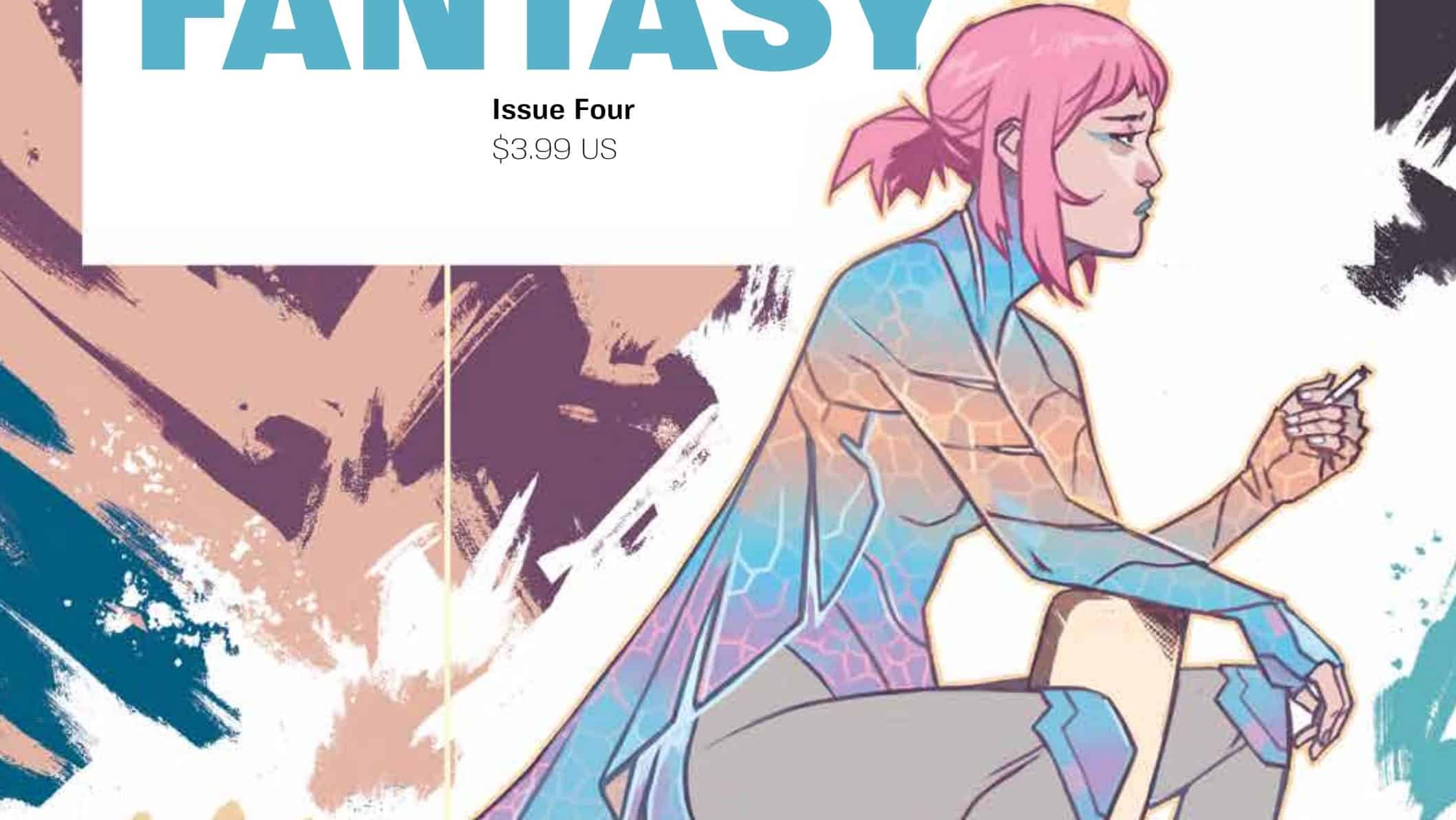On July 16, 1945, the world changed forever. Santa Valentina was born. There was also the Trinity test, but that’s not as important. As the world hangs in the balance, we explore the life and times of the girl who fell … skipped? … to Earth.
Also: check out that cow!
The Power Fantasy #3 is written by Kieron Gillen, drawn by Caspar Wijngaard, lettered by Clayton Cowles and designed by Rian Hughes for Image Comics.
Rasmus Skov Lykke: OK, let’s start with the elephant in the room, the thing everyone is wondering about. The cow from the cover is not in this issue.
Austin Gorton: [smashes keyboard, flips desk]
Rasmus: I know, I know. I was as disappointed as you. This cow is clearly the breakout star of 2024, so relegating her to only a cover appearance is downright criminal, and I expect to see Gillen and Wijngaard brought to justice.
Now with that awful business taken care of, we can talk about the rest of the issue, where nothing as horrendous happens, I assume.
Austin: Certainly nothing like the destruction of an entire continent. Er, uh, we’re getting ahead of ourselves.
Sentimental Journey

Rasmus: The issue opens with the first in-comic depiction of the story’s starting point. Gillen has been very clear in interviews that the story spans 55 years, from 1945 to 1999. And while we don’t know why it ends in 1999, he has also been clear about why it starts in 1945, with the first nuclear explosion, at Los Alamos.
Like Gillen’s Avengers/X-Men/Eternals: Judgment Day was an exploration of climate change, The Power Fantasy is — among many other things — an exploration of nuclear power. And this is the scene that makes all of that very explicit for the reader, as the first nuclear explosion is paired with the birth (arrival?) of Valentina.
Austin: It’s all terribly on the nose, of course (two world-changing events happening in concert, one familiar from real-world context which provides a point of reference for the impact of the fictional one), but I like the way Wijngaard lays out the visuals and leans into the parallelism: the way the top of Valentina’s head emerges just as the mushroom cloud begins to form, the way she zips out of her mother (host?) at the same time the cloud reaches its zenith.
Also, did I miss this in a previous issue, or is this when it first gets confirmed that Valentina is NOT one of the Atomics, but rather, something else?
Rasmus: The recap page of issue #2 actually has an infographic showing all six superpowers. Etienne Lux, Morishita Masumi and Brother Ray “Heavy” Harris are Atomics, Santa Valentina and Eliza Hellbound are “Extradimensional Entities aka ‘Angels’ and ‘Demons’” and Jacky Magus is the sole member of the grouping titled “Extradimensional Channelers aka ‘Magicians.’” Which is all wonderfully interesting and makes me wonder about what creates these distinctions and how it’ll impact everything going forward.
Austin: The Valentina/A-bomb birth sequence gets invoked again at the “end” of the sequences of flashbacks in this issue, thereby creating a parallel within the parallel. Here, Valentina gets caught in an atomic (lowercase A) blast detonated by the Nixon administration (checks out) in an attempt to remove her from the board. Following this second atomic “birth,” she flies into the Oval office, glowing with radiation, angry about all the people who died because she was a target. She doesn’t seek retribution at this time (though everyone in the room eventually dies from the radiation), nor does the Valentina of 1969 seem radically different from her “present” day demeanor. But it seems like Gillen is setting something up here, using the imagery of the dual atomic parallels to suggest this moment as a rebirth of sorts for Valentina.
Rasmus: It also raises an interesting question.
Because while Valentina is the first of the superpowers, the vast majority of them are classified as “Atomics.” And so we’re led to believe the atom bomb kicked off the arrival of the superpowered people, the Atomics. But it could actually be Valentina’s birth instead, with her as a herald of a new age.
We also get the first meeting between Lux and Valentina. And once again, Lux is giving me Lex Luthor vibes. He is less subtle as a kid. He admits to several damning things. He mainly (only?) wants to be friends with Valentina because he can’t enter her mind. So to keep tabs on her — control of her? — he needs them to be friends. He says he only stopped “The Devil,” a rogue Atomic, at the time he did because it had forced Valentina to come out of the shadows. He’s masterminding the whole thing.
Austin: “Is Etienne Lux Actually the Villain of All This?” is definitely a theory with legs.
Rasmus: Yet he also steps in as early as possible, to minimize the lives lost, because “it’s the ethical thing to do.” There’s a certain number of lives that he’s very comfortable losing, in order to do the ethical thing.
He’s the epitome of “the ends justify the means.” And the scary thing is he might be right, in the fight for the future.
Austin: He’s definitely very Ozymandias-coded in that. Whether that’s meant to be a setup or a swerve remains to be seen.
The Music of the Future

Rasmus: It’s been literally decades since the first time I heard The Tornados’ “Telstar,” and it still sounds like the music of the future.
I won’t go into the entire history and context of the song (Andrew Hickey already did a much better job of that, with his tremendous A History of Rock Music in 500 Songs), but suffice to say, in 1962 this sounded even more like the future. And more importantly, it is the kind of song — the kind of art — that makes one wish for a future where more of this kind of daring, expressive, interesting art can flourish. The kind of thing that makes it clear that the future is worth fighting for.
Austin: Or, as Valentina says, that the music of the future needs a future to exist in. Thus, “Telstar” becomes shorthand for Valentina deciding to intervene. This plays out against the backdrop of the Cuban Missile Crisis (more atom bombs). It’s clear that Valentina already has intervened (relative to “real” history) — a radio report notes she’s already rendered intercontinental strikes ineffective, somehow — yet her decision to put a stop to the Cuban Missile Crisis in full is clearly spurred on by the music of The Tornados, given to her by Etienne. And the ominous note it ends on — present day Etienne regrets introducing Valentina to “Telstar” — suggests we’re being primed for a bigger — and more catastrophic — example of Valentina acting to save the future to come.
Rasmus: Possibly.
The good person doing horrible things is something Gillen has done before, so it could be a pattern. Or — as I mentioned earlier — it could be that Valentina is spoiling Lux’s plans.
Austin: Right, if Lux is “the villain” (in whatever form that takes), that he’d be bummed he’s inspired this bit of further heroic “meddling” in Valentina.
Rasmus: After Valentina single-handedly handles the crisis, she talks to Lux and says “Do you approve? It seems like your sort of thing,” to which he replies, “Yes. It is. That’s what worries me. I thought you were going to sit by.” It could be that he regrets sending her the record because it didn’t have the effect he’d hoped for. He didn’t predict her reactions correctly, and thus couldn’t manipulate her as he wanted.
Or it’s the other way around. He did want to manipulate her to “solve” the crisis, but it showed him how easily she could be manipulated and that puts him in an awful spot ethically.
Austin: You can read The Power Fantasy #3 from two different perspectives, one hinting at Lux being the bad guy, actually, and another hinting at Valentina being, if not a villain exactly, bringing about something apocalyptic.
Rasmus: This dilemma of never quite knowing where the characters stand, there definitely not being clear heroes and villains, is one of my favorite parts of this series.
The Final Countdown

Austin: Which isn’t to say that I think Valentina is somehow responsible for the other big reveal of the issue (the closing data page spells out the cause pretty clearly even if the dramatization of it is still to come): that in the world of The Power Fantasy, the vast majority of Eurasia was obliterated in 1989.
Rasmus: Yeah, after it had been teased for two issues, we finally get a look at why everyone is so upset when talking about The Second Summer of Love.
And I have to say, this really struck me.
I’ve seen New York destroyed too many times to count. Watched the Golden Gate Bridge collapse, the Eiffel Tower broken in half and Big Ben fall apart in slow motion. It’s just something that happens, at this point. Something to show the stakes our heroes are up against. Sure, it’s awful, but A) it can be rebuilt and B) we’ve seen it too many times.
But seeing so much of Europe — basically all of Western Europe — destroyed …
I immediately started trying to map which countries had been affected, searching for Denmark (where I’m from). I almost didn’t expect to find it destroyed, because it’s such a small country that it rarely shows up in anything. And it didn’t show up here either. Because it didn’t exist anymore.
Not only didn’t it exist anymore, the destruction of my home country — the place I grew up, where my entire family is from, where I’ve lived my entire life, where my daughter was born — didn’t even matter. Because the scales are enormous.
But that’s the European perspective. How did it land for you, Austin?
Austin: While I’ve been watching American landmarks blow up most of my life — I was there for Independence Day in the theater — even for me there’s something about the nature of this particular cataclysm that hits harder. This isn’t a man-made landmark, or even some kind of Watchmen-esque (or Thanos snap-style) population decimation — the actual continental bedrock has been destroyed, such that Europe is now mostly ocean with a few swirls of land remaining. There’s something more thorough and, I guess, fundamental to an event like that. Even when, say, the Hulk goes on a rampage, he’s not in risk of obliterating the land he’s standing on. Yet that’s what happened here. It’s a visual shorthand for an immense level of power.
Rasmus: And like all great cliffhangers, it desperately made me want to learn more.
Which made the actual final page so interesting. Because here we get a timeline of “Major Public Actions of the Superpowers (1945-1999).”
Austin: I love this kind of stuff so much — hints at future plot points/reveals that grow more interesting once you’ve encountered them.
Rasmus: It is intriguing enough on its own — both giving us a bit more information about events we’ve already encountered, while also hinting at upcoming events (I, for one, can’t wait to meet The Major and see what kind of bastard he is) — but the most interesting thing about it is that it clearly states when we’ll read about these events. Sort of like editor’s notes from old comics, telling us to “Read all about Etienne Lux’s origin in the now classic The Power Fantasy #12!” Except this is issue #3 and issue #12 hasn’t been created yet.
Austin: As someone who appreciates a good plan/outline when it comes to creative writing, I have to applaud this kind of planning.
Rasmus: It’s such a confident statement by Gillen and Wijngaard, laying out a clear plan for the first 12 issues. These things have to happen in these issues now. They’re locking themselves in, committing to not only a certain plot, but also the pacing of it.
It’s a promise of things to come, as well as a promise that they’ve got this. Everything has been carefully planned. We can rest easy and shouldn’t worry about the future. And definitely shouldn’t worry about the timeline going to 1999, the final listed event being in 1989, and 1999 coming in right around where Rian Hughes has placed a giant, red “Power Off” button.
Fantasizing About Power
- I (Austin) recently went on a trip with my wife to Boston, and we visited the JFK library, which has a section devoted to the Cuban Missile Crisis. It was one of those weird bits of coincidental synergy when I returned home to find this issue waiting.
- We didn’t touch on it enough, but the art by Wijngaard continues to be astounding. I especially dug the watercolor-y feel of 1957 Toulouse. But every choice just fits the scene perfectly.
- To that point, it’s really neat how the coloring grows more strident as it draws closer to the present, going from something almost pastel to darker, more traditional comic book coloring.
- I (Rasmus) don’t want to make too much of it yet, because it could just be an error, but there’s a discrepancy in when the comic says “the Devil” incident happened. We see Lux and Valentina talk about it in Toulouse in 1957, yet the timeline in the back says it happened in 1960. It might hint at an unreliable narrator, that the infographics and the comic aren’t told by the same narrator, revisionist history or something else altogether. Or it might just be a small error that slipped through the editorial process.
Buy The Power Fantasy #3 here. (Disclaimer: As an Amazon Associate, ComicsXF may earn from qualifying purchases.)






